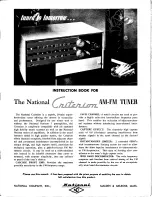
Advanced Operations
En-59
■
TrueHD Loudness Management
`
Off
`
On
This setting specifies whether or not to apply the Late
Night processing on a Dolby TrueHD source.
Note
• When this setting is set to “
Off
”, the Late Night function for
Dolby TrueHD sources is automatically fixed to “
Off
”.
• When this setting is set to “
Off
”, the Dialogue Normalization
information is not available for Dolby TrueHD sources.
DTS
■
Neo:6 Music
Center Image
`
0
to
2
to
5
The DTS Neo:6 Music listening mode creates 6-channel
surround sound from 2-channel stereo sources. With this
setting, you can specify by how much the front left and
right channel output is attenuated in order to create the
center channel.
Changing the value from “
0
” to “
5
” will spread the sound
of the center channel to left and right (outwards).
Audyssey DSX
®
■
Soundstage
`
–3dB
to
Reference
to
+3dB
With this setting, you can adjust the sound stage when using
Audyssey DSX.
Note
• This listening mode can be selected only when all the following
conditions are satisfied:
– The center speaker is connected.
– Either the front high or front wide speakers are connected.
– Powered Zone 2 is not in use.
Theater-Dimensional
■
Listening Angle
`
Wide
:
Select if the listening angle is greater than 30 degrees.
`
Narrow
:
Select if the listening angle is less than 30 degrees.
With this setting, you can optimize the Theater-
Dimensional listening mode by specifying the angle of the
front left and right speakers relative to the listening
position. Ideally, the front left and right speakers should be
equidistant from the listening position and at an angle close
to one of the two available settings.
Note
• For best results, we recommend setting “
Narrow
” to 20° and
“
Wide
” to 40°.
LFE Level
■
Dolby Digital
*1
, DTS
*2
, Multich PCM, Dolby
TrueHD, DTS-HD Master Audio, DSD
*3
`
–
Q
dB
,
–20dB
,
–10dB
, or
0dB
With these settings, you can set the level of the LFE (Low
Frequency Effects) channel individually for each input
sources.
If you find that low-frequency effects are too loud when
using one of these sources, change the setting to –20 dB or
–
Q
dB.
*1
Dolby Digital and Dolby Digital Plus sources
*2
DTS and DTS-HD High Resolution sources
*3
DSD (Super Audio CD) sources
Dialogue Normalization
Dialogue Normalization (DialogNorm) is a feature of
Dolby Digital, which is used to keep the programs at the
same average listening level so the user does not have to
change the volume control between Dolby Digital,
Dolby Digital Plus and Dolby TrueHD programs. When
playing back software which has been encoded in Dolby
Digital, Dolby Digital Plus and Dolby TrueHD,
sometimes you may see a brief message in the front
panel display which will read “
DialogNorm: X dB
” (X
being a numeric value). The display is showing how the
program level relates with THX calibration level. If you
want to play the program at calibrated theatrical levels,
you may wish to adjust the volume. For example, if you
see the following message: “
DialogNorm: + 4 dB
” in
the front panel display, to keep the overall output level at
THX calibrated loudness, just turn down the volume
control by 4 dB. However, unlike a movie theater where
the playback loudness is preset, you can choose your
preferred volume setting for best enjoyment.
Front left speaker
Front right speaker
Listening angle:
30°
Summary of Contents for DTR-40.4
Page 1: ...AV Receiver DTR 40 4 Instruction Manual ...
Page 102: ...Appendix En 102 Memo ...
Page 103: ...Appendix En 103 Memo ...
















































